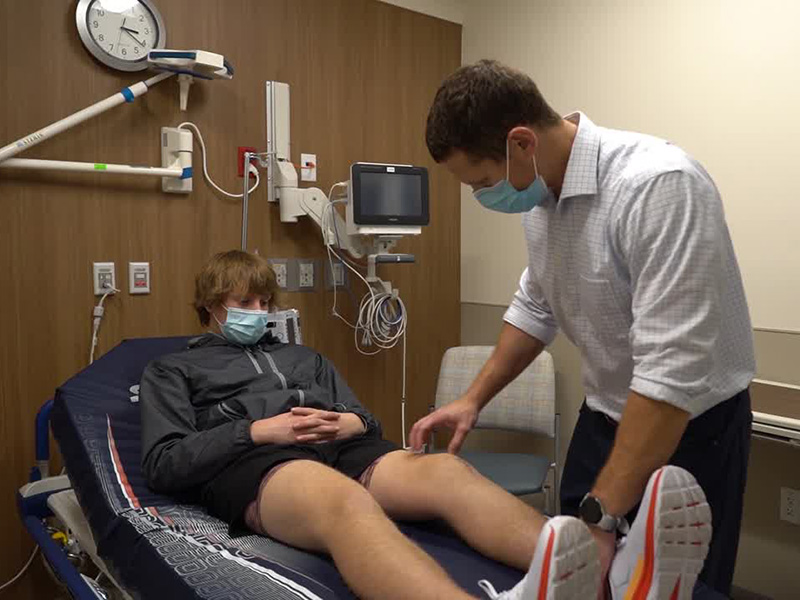Anthony Kasch, M.D., specializes in sports medicine at Sanford Orthopedics and Sports Medicine in Bismarck, North Dakota. Dr. Kasch received his medical degree from the University of Colorado School of Medicine in Aurora, Colorado, and completed his orthopedic residency at the University of Arizona in Tucson, Arizona. He also completed a fellowship specializing in sports medicine at Kaiser Permanente in San Diego, California. Call (701) 323-8920 to schedule an appointment.
Sanford Health News recently sat down with Dr. Kasch to answer questions about a common sports injury: ACL tears and ruptures.
Q: What is an ACL injury?
A: The anterior cruciate ligament (ACL) connects the femur (thigh bone) to the tibia (shin bone). The ACL is in the center of the knee and controls rotation and forward movement of the tibia, acting as one of the main stabilizing ligaments in the knee.
When the knee is forced beyond its normal range of motion, the ligament can tear and cause the knee to become unstable. This can be especially noticeable during activities such as walking downstairs or pivoting on one leg.
Q: What can cause this type of injury?
Tears or ruptures of the ACL can result from a contact or non-contact injury. A contact injury is from direct trauma to the knee, such as when a football player collides into the side of another player. Non-contact injuries may occur when someone suddenly pivots while their foot is still planted on the ground or when an athlete lands wrong after a jump and hyperextends their knee.
Q: What are signs of an ACL injury?
A: At the time of injury, people often feel or hear a pop in the knee, followed by sharp pain and a feeling of instability. Other symptoms may include swelling, aching pain and sudden leg buckling or “giving out” while trying to stand. People may also experience a limited range of motion, inability to bear weight, tenderness around the knee joint, bruising and, in some cases, numbness below the knee.
Q: How common are ACL injuries?
A: Tearing the ACL is one of the most common knee ligament injuries – making up more than 50% of all knee injuries. Although anyone can injure their ACL, certain activities like skiing, soccer and football put people at higher risk.
Q: What should people do if they suspect they have torn their ACL?
A: If someone may have an ACL tear, they should see a sports medicine specialist and immediately follow the RICE method.
Rest: Avoid activities that cause knee pain until symptoms subside.
Ice: Apply ice packs several times throughout the day for 10 to 20 minutes.
Compression: Wear a tight, elastic bandage around the knee.
Elevation: Keep the knee elevated above the waist.
A sports medicine specialist will evaluate the injury before creating a treatment plan. This will include examining the knee for swelling, tenderness, pain points and motion limitations before considering nonsurgical and surgical treatment options.
Treatment options after an ACL injury
Q: What is an ACL injury?
A: Tearing the anterior cruciate ligament (ACL) is one of the most common knee ligament injuries. Injury to this ligament often occurs when the knee is forced beyond its normal range of motion, causing the ligament to stretch or tear.
Q: What should someone do if they suspect they tore their ACL?
If someone suspects an ACL injury, they should see a sports medicine specialist to have their injury evaluated for treatment and rehabilitation.
Without treatment, swelling and pain will generally subside over several weeks, but instability may continue to hinder a person’s ability to play sports or even perform everyday activities like standing from a seated position, walking downstairs or pivoting on one leg.
Q: Who may be a candidate for nonsurgical treatment options?
A: Candidates for nonsurgical treatments include those who don’t have knee instability affecting their daily living and those who don’t participate in activities that involve sudden stops or turns. Nonsurgical treatment options may include physical therapy, wearing a knee brace, restricting knee movement and taking medications like ibuprofen or naproxen.
Q: How long does recovery take?
Recovery time varies between each person and may take a few weeks to a few months. Because not all ACL injuries fully heal with nonsurgical treatment, those who wish to return to sports or robust physical activities should talk with their provider about surgery options.
Q: When does an ACL tear require surgery?
A: The need for surgery to repair an ACL tear depends on the severity of the injury and a person’s lifestyle. If someone has a completely torn ACL, it will not be able to heal on its own. A sports medicine specialist can help determine if surgery is the best option.
Q: How is ACL surgery performed?
A: In most cases, surgery involves ACL reconstruction, which replaces the torn ACL with tissue called a graft. This tendon tissue is taken from another part of the body. Today, with innovative advancements, patients can often return home the same day of their surgery to begin recovery.
Q: What is the recovery process like after surgery?
A: Within a few days of surgery, patients can meet with a physical therapist or specialist to start an exercise program tailored to their specific injury. Rehabilitation is essential for improving range of motion, increasing strength and restoring balance for the long term. Typically, athletes can return to playing sports nine to 12 months following surgery.
Learn more
- Bismarck athlete bounces back from ACL injury with help from Sanford
- ACL injury is focus of Fargo researchers
- How to treat strains, sprains, fractures and breaks
…
Posted In Bismarck, Physicians and APPs, Sports Medicine

